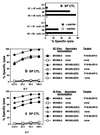Mucosal vaccination overcomes the barrier to recombinant vaccinia immunization caused by preexisting poxvirus immunity
- PMID: 10200293
- PMCID: PMC16363
- DOI: 10.1073/pnas.96.8.4512
Mucosal vaccination overcomes the barrier to recombinant vaccinia immunization caused by preexisting poxvirus immunity
Abstract
Overcoming preexisting immunity to vaccinia virus in the adult population is a key requirement for development of otherwise potent recombinant vaccinia vaccines. Based on our observation that s.c. immunization with vaccinia induces cellular and antibody immunity to vaccinia only in systemic lymphoid tissue and not in mucosal sites, we hypothesized that the mucosal immune system remains naive to vaccinia and therefore amenable to immunization with recombinant vaccinia vectors despite earlier vaccinia exposure. We show that mucosal immunization of vaccinia-immune BALB/c mice with recombinant vaccinia expressing HIV gp160 induced specific serum antibody and strong HIV-specific cytotoxic T lymphocyte responses. These responses occurred not only in mucosal but also in systemic lymphoid tissue, whereas systemic immunization was ineffective under these circumstances. In this context, intrarectal immunization was more effective than intranasal immunization. Boosting with a second dose of recombinant vaccinia was also more effective via the mucosal route. The systemic HIV-specific cytotoxic T lymphocyte response was enhanced by coadministration of IL-12 at the mucosal site. These results also demonstrate the independent compartmentalization of the mucosal versus systemic immune systems and the asymmetric trafficking of lymphocytes between them. This approach to circumvent previous vaccinia immunity may be useful for induction of protective immunity against infectious diseases and cancer in the sizable populations with preexisting immunity to vaccinia from smallpox vaccination.
Figures




Similar articles
-
Oral Immunization with Recombinant Vaccinia Virus Prime and Intramuscular Protein Boost Provides Protection against Intrarectal Simian-Human Immunodeficiency Virus Challenge in Macaques.Clin Vaccine Immunol. 2015 Dec 30;23(3):204-12. doi: 10.1128/CVI.00597-15. Clin Vaccine Immunol. 2015. PMID: 26718849 Free PMC article.
-
Mucosal immunization with HIV-1 peptide vaccine induces mucosal and systemic cytotoxic T lymphocytes and protective immunity in mice against intrarectal recombinant HIV-vaccinia challenge.Proc Natl Acad Sci U S A. 1998 Feb 17;95(4):1709-14. doi: 10.1073/pnas.95.4.1709. Proc Natl Acad Sci U S A. 1998. PMID: 9465081 Free PMC article.
-
An experimental prime-boost regimen leading to HIV type 1-specific mucosal and systemic immunity in BALB/c mice.AIDS Res Hum Retroviruses. 1998 Mar 20;14(5):401-7. doi: 10.1089/aid.1998.14.401. AIDS Res Hum Retroviruses. 1998. PMID: 9546799
-
Routes of immunization and antigen delivery systems for optimal mucosal immune responses in humans.Behring Inst Mitt. 1997 Feb;(98):33-43. Behring Inst Mitt. 1997. PMID: 9382757 Review.
-
Optimization of live oral Salmonella-HIV-1 vaccine vectors for the induction of HIV-specific mucosal and systemic immune responses.J Biotechnol. 1996 Jan 26;44(1-3):203-7. doi: 10.1016/0168-1656(95)00151-4. J Biotechnol. 1996. PMID: 8717405 Review.
Cited by
-
Evaluation of the safety and immunogenicity of a candidate tuberculosis vaccine, MVA85A, delivered by aerosol to the lungs of macaques.Clin Vaccine Immunol. 2013 May;20(5):663-72. doi: 10.1128/CVI.00690-12. Epub 2013 Feb 27. Clin Vaccine Immunol. 2013. PMID: 23446219 Free PMC article.
-
Prime-boost immunization schedules based on influenza virus and vaccinia virus vectors potentiate cellular immune responses against human immunodeficiency virus Env protein systemically and in the genitorectal draining lymph nodes.J Virol. 2003 Jun;77(12):7048-57. doi: 10.1128/jvi.77.12.7048-7057.2003. J Virol. 2003. PMID: 12768024 Free PMC article.
-
Preexisting immunity to poliovirus does not impair the efficacy of recombinant poliovirus vaccine vectors.J Virol. 2001 Jan;75(2):622-7. doi: 10.1128/JVI.75.2.622-627.2001. J Virol. 2001. PMID: 11134275 Free PMC article.
-
Single-dose replicating poxvirus vector-based RBD vaccine drives robust humoral and T cell immune response against SARS-CoV-2 infection.Mol Ther. 2022 May 4;30(5):1885-1896. doi: 10.1016/j.ymthe.2021.10.008. Epub 2021 Oct 20. Mol Ther. 2022. PMID: 34687845 Free PMC article.
-
Utilizing IL-12, IL-15 and IL-7 as Mucosal Vaccine Adjuvants.Lett Drug Des Discov. 2006;3(8):586-592. doi: 10.2174/157018006778194655. Lett Drug Des Discov. 2006. PMID: 17496983 Free PMC article.
References
MeSH terms
Substances
LinkOut - more resources
Full Text Sources
Other Literature Sources

